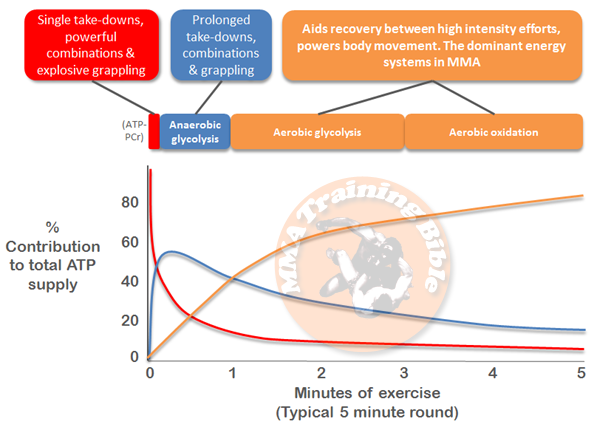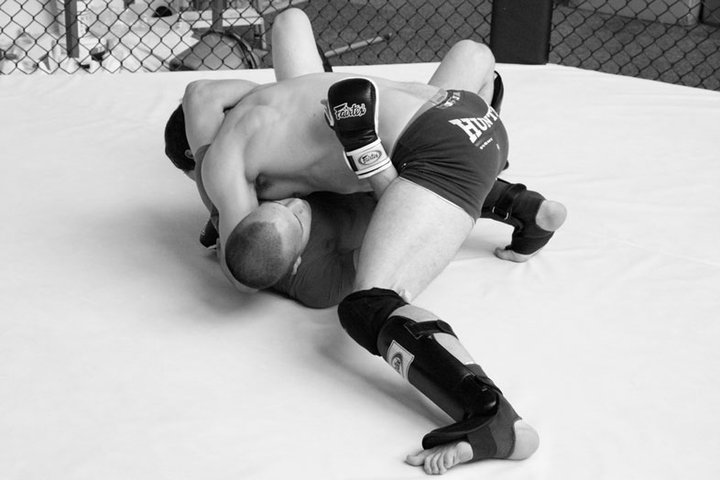Before you read this article, make sure you get up to speed with Part 1, Part 2, and Part 3.
Not all cardio workouts are created equal and subtle changes in the work-to-rest ratio or work interval length of a training session can bring about very different adaptations that may or may not be useful to you on fight day. The purpose of this five-part article is to examine the metabolic demands of mixed martial arts and teach you how to bring about specific physiological and biochemical training adaptations that will improve your performance in the cage.
In Part 1 you learned about the basics of energy transfer. Part 2 focused on the ATP-PCr system, which supports maximal effort in the 0 s to 30 s range. Part 2 also showed you how to target the ATP-PCr system by manipulating the work interval length, rest interval length and the work-to-rest ratio of your training sessions. Part 3 focused on anaerobic glycolysis, which supports maximal effort in the 30 s to 90 s range. You also learned how to target anaerobic glycolysis in your training sessions.
The present section represents a turning point. Up to now you have been learning about the anaerobic energy systems. These systems support powerful movements like take-downs and high intensity combinations, but they do not support your ability to perform these powerful movements over and over again. The ability to perform repeated efforts at a high intensity over a whole fight is supported by the aerobic energy systems.
Part 4 will focus on aerobic glycolysis, which aids recovery between high intensity efforts and powers repeated high intensity movement in the cage. The main objectives of this article are to, 1) teach you how this system works; 2) show you how to target it with exercise; 3) list the physiological and biochemical adaptations that may occur when you train it. Let’s get on with it.
How the system works
Aerobic glycolysis supports prolonged high intensity effort in the 90 s to 3 minute range. The contribution this energy system makes towards your maximal effort over a typical five minute round is shown below in Fig 8.
 Fig 8. The ATP-PCr system supports maximal activity in the 0 s to 30 s rang. Anaerobic glycolysis supports prolonged high intensity efforts lasting 30 s to 90 s. Aerobic glycolysis supports activity in the 90 s to 3 minute range.
Fig 8. The ATP-PCr system supports maximal activity in the 0 s to 30 s rang. Anaerobic glycolysis supports prolonged high intensity efforts lasting 30 s to 90 s. Aerobic glycolysis supports activity in the 90 s to 3 minute range.There are a few interesting things to point out in Fig 8. First, high intensity efforts supported by the ATP-PCr system and anaerobic glycolysis cannot be sustained for much longer than around 75 s, as this represents the cross-over point when aerobic energy systems begin to dominate ATP production (6). Also notice that aerobic glycolysis generates ATP at a slower rate than the anaerobic energy systems, but it can sustain it for much long periods.
Aerobic glycolysis is very similar to anaerobic glycolysis in that it uses 10 chemical reactions to produce some energy, a few electron carriers, and pyruvate. As you learned in Part 3 of this series, when there is no oxygen around after these 10 chemical reactions have taken place, pyruvate is converted into lactic acid. But when there is oxygen available after these 10 chemical reactions, pyruvate is converted into something called acetyl-Coenzyme-A, which is used to produce more energy (We’ll cover this in Part 5). For our purpose, that is all you need to know about how aerobic glycolysis works.
Targeting aerobic glycolysis
The aerobic energy systems are essential for PCr resynthesis, and if you have a high level of aerobic fitness, you should be able to more rapidly resynthesize PCr between high intensity repeated efforts (3, 4). For this reason, training interventions that target aerobic glycolysis may increase the rate of PCr resynthesis and improve your performance in the cage.
When your goal is to target the capacity of aerobic glycolysis, a typical workout might use work-to-rest ratios of 1:3 to 1:4, and have a work interval of around 90 s to 3 minutes (5, 6). But by reducing the amount of rest between work intervals in the 2 minute range, scientists have found that you may be able to target other metabolic processes that are important in MMA. For example, because the accumulation of hydrogen ions in the muscles and blood may impair your performance in the cage, it seems probable that increasing their removal during exercise (called buffering) may enhance your performance. It appears that 2 minute work intervals separated by short rest periods of 1 to 3 minutes may improve buffering (2). Also, the rate at which your body can resynthesize PCr will probably improve your ability to perform repeated high intensity efforts. PCr resynthesis also appears to improve when shorter rest intervals are taken (i.e. 2 min on, 1 min off) (1). Typical workouts that target aerobic glycolysis might look like this: 4 x (2 min on, 7 min off, 1 min build-up). As I’ve said before, many possible workouts can target the aerobic glycolytic system, so if you’re looking for support designing a fully periodized training plan, consider enrolling in our training courses.
Training adaptations
Training adaptations that result from targeting aerobic glycolysis are very similar to those resulting from targeting anaerobic glycolysis in that you may observe an increase in the availability of muscle glycogen and an increase in the activity of glycolytic enzymes (5, 6). Both of these adaptations have the effect of increasing ATP production and your power output in the cage. Your body’s ability to buffer hydrogen ions and lactate from your muscles may also improve (5, 6). Your body’s ability to take in oxygen and deliver it to working muscles may also improve.
Take-home messages
- Aerobic glycolysis supports activity in the 90 s to 3 minute range. It also aids recovery between high intensity efforts and powers high intensity movement in the cage.
- Target aerobic glycolysis using work-to-rest ratios of 1:3 to 1:4 and a work interval of around 90 s to 3 minutes. But by reducing the amount of rest between work intervals in the 2 minute range, you can improve PCr resynthesis and improve hydrogen ion buffering.
- Typical adaptations that result from training anaerobic have the effect of increasing ATP production and your power output in the 90 s to 3 minute range, and also feature an improved ability to perform repeated high intensity efforts.
Click here to read the next article in the series; Part 5.
Part 4 References
- Bishop et al., Am J Physiol Regul Integr Comp Physiol 295:R1991-R1998 (2008)
- Edge & Bishop Eur J Appl Physiol 96:97-105 (2006)
- Harris et al., Pflugers Arch 367:137-142 (1976).
- Haseler et al., J Appl Physiol 86:2013-8 (1999)
- Kreamer WJ, Fleck SJ, Deschenes MR. (2012). Exercise Physiology: Integrating Theory and Application. Lippincott Williams & Wilkin: China.
- Plowman SA, Smith DL. (2011). Exercise Physiology: For Health, Fitness, and Performance (3rd ed.). China: Lippincott Williams & Wilkins.

Leave a Reply